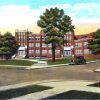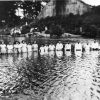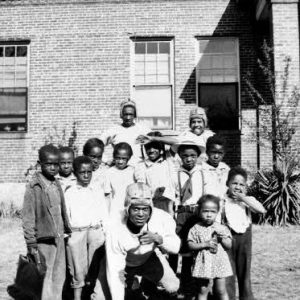calsfoundation@cals.org
Consolidated White River Academy
The Consolidated White River Academy arose in the late 1800s when several African-American church groups in the Brinkley (Monroe County) area wanted to create an academy offering African-American students the opportunity for a full high school education, rather than the mere tenth-grade education available to them in the area. The goal was to provide a top-notch Christian education in a boarding school environment following a modified version of Alabama’s Tuskegee Institute. The educational opportunities and convenient residential facilities attracted students from across the state and nation for over fifty years.
The district academy project originated during the late nineteenth century with black Baptist churches in the Brinkley area. These churches worked to establish a high school, the original name of which was the Consolidated White River Baptist District Academy. The academy organizers purchased 11.5 acres of land on the west side of the intersection of West Hemlock and Charlyne streets around 1893, and a seven-room house there served as the principal’s home and girls’ dormitory. Soon, a two-story building was constructed to house classrooms and a boys’ dormitory, though it was destroyed in the 1909 tornado that devastated much of the city. The academy’s first session began on January 1, 1893, in Mt. Zion Baptist Church in Brinkley and was led by Professor J. W. Ware, who was known as a scholar, orator, and teacher. By the end of the second session in 1894, the academy had about seventy-five pupils. The third session began in October 1895 with Professor J. P. Gettis as principal and his wife, who acted as matron for the girls’ dormitory, as his assistant.
Black students seeking a complete high school education flocked to the academy. Some students were from the Brinkley area, but others came from places like Pine Bluff (Jefferson County), Hot Springs (Garland County), and Searcy (White County), along with others from as far away as Chicago, Atlanta, and St. Louis. In its early days, the tuition was six dollars a month, and students received instruction in Latin, English, math, and sciences. Vocational classes were offered. At various times, the school offered basketball, football, baseball, and tennis. Since the school was founded and supported by churches, religion was an essential part of the daily curriculum; Bible study was mandatory. Uniforms were also required; boys wore dark pants and white shirts, while girls wore blue pleated skirts, white blouses, blue ties, black shoes, and academic caps. Uniforms were abandoned in 1943.
Because the academy’s administration wanted as many students as possible to be exposed to a quality education, tuition was occasionally waived. At times, the Ladies’ White Rose Club, an African-American ladies club, of Brinkley paid a needy student’s tuition, while other students worked in the school’s apprenticeship program or had jobs on campus to pay their tuition. Local black churches provided all the food and some of the books and supplies for the school.
The twentieth century saw an increasing number of public schools providing black students with education through the twelfth grade; this, combined with a number of black residents moving north for economic opportunity, resulted in a drop in enrollment. These factors, along with a lack of financial support, caused the academy to shut down in 1950. What remained of the large, two-story brick building, complete with porches and a chapel (which had replaced the building that housed classrooms and the boys’ dormitory after it was destroyed by fire), was removed in the mid-1980s.
For additional information:
Almond, Holly. “Consolidated White River Academy.” In Brinkley Centennial Yearbook. Brinkley, AR: Brinkley Centennial Commission, 1972.
Cohns, Emma. “Interview with Emma Cohns: Consolidated White River Academy.” August 23, 2013. Audio online at Butler Center AV/AR Audio Video Collection. Emma Cohns Interview (accessed September 19, 2022).
Consolidated White River Academy Stockholders’ Association Minutes Book. Butler Center for Arkansas Studies. Central Arkansas Library System, Little Rock, Arkansas. Finding aid online at http://purl.oclc.org/arstudies/bc-mss-1455 (accessed September 19, 2022).
C.W.R.B.D. Academy.” The Brinkley Globe. January 24, 1896, p. 1.
Hicks, Melvina. “Interview with Melvina Hicks: Consolidated White River Academy.” August 23, 2013. Audio online at Butler Center AV/AR Audio Video Collection. Melvina Hicks Interview (accessed September 19, 2022).
Amanda Manatt
KATV
Louise Mitchell
Central Delta Historical Society
 Education, Elementary and Secondary
Education, Elementary and Secondary Religion
Religion Consolidated White River Academy
Consolidated White River Academy  Consolidated White River Academy Girls Basketball Team
Consolidated White River Academy Girls Basketball Team 




The photo of the girls’ basketball team is very special to me. Two of my aunts are in this photo. Kneeling on the front row, right, is my father’s youngest sister, Theressa Gant-Neal. Standing in the top row, fourth from the right, is my mother’s youngest sister, Mosalee Malone. She passed away in the late 1960s. They both were from Woodruff County, near Augusta, Arkansas. I have seen this photo before, but I was surprised and excited to see it on your homepage as a Photo of the Day. This school is a big part of my family’s history and my family spoke of it often.
I was very inspired by these interviews. One was with my Aunt Emma Cohns, who is my deceased father’s youngest sister and the last survivor of four children. Today at eighty-seven years young she is still as sharp as the sound of a fiddle and still is sharing information on our family history. I think this was a wonderful idea and should be continued to enhance the teaching of history in the Arkansas educational system.